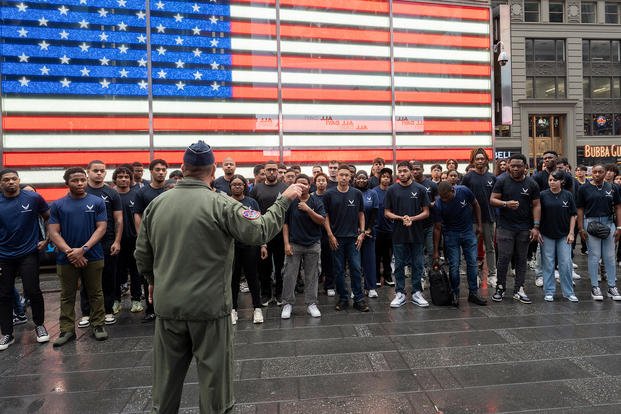
The Air Force had to reduce its target recruiting goal by several thousand airmen due to ongoing congressional budget delays, but is still on pace to hit its newly revised benchmark by the end of this month, according to the service.
Chief Master Sgt. Frank Rawls, the top recruiter for the Air Force, told Military.com in an interview Tuesday that the service is “96%” of the way to its active-duty goal of 29,950 airmen with expectations it will hit that number by the end of this month — roughly three months ahead of schedule
Last year, the Air Force announced a much more ambitious benchmark of 32,500 active-duty airmen, according to a list of goals provided by the Air Force Accessions Center after hitting its 2024 numbers.
While the Air Force is still on pace to hit or even surpass that higher goal by the end of the fiscal year, the number was reduced by a little more than 3,000 recruits. Joe Gangemi, an Air Force Ascensions Center spokesperson, said the goal was reduced in April.
During testimony in front of the House Armed Services Committee earlier this month, Air Force Chief of Staff Gen. David Allvin said the move was due to the ongoing continuing resolution — a stopgap measure passed by Congress in lieu of an annual budget that holds funding to the previous year’s levels.
“We suffered a recruiting setback due to the yearlong continuing resolution and subsequent reduction of nearly half a billion dollars in our military personnel account,” Allvin said during the June 5 hearing. “This will result in our inability to fund the recruitment of 3,000 Americans who want to join our Air Force.”
The service suffered a post COVID-19 pandemic-era recruiting slump, which led to it missing an annual recruiting goal in 2023 for the first time since the 1990s. Since then, it has been working diligently to turn the tide by hiring more recruiters, changing policies and tracking monthly goals, Rawls told Military.com.
Additionally, Rawls said the Air Force has greatly expanded its delayed-entry program — the waiting area where recruits continue to prepare as they await their shipment date and job code for boot camp — increasing it from 4,000 in 2023 to roughly 12,000 today.
He added that it has been a significant accomplishment by the Air Force’s 1,600 recruiters.
“At the end of the day with such a small force, it’s very challenging with the level of bandwidth and the area of coverage that each one of these recruiters is responsible for, to be able to do some of those things,” Rawls said.
Defense Secretary Pete Hegseth has implied that the changes in the recruiting environment for all the services are due to the new administration and the Pentagon’s cultural shift. But experts as well as service officials have pointed out to Military.com that those shifts began under former President Joe Biden and former Defense Secretary Lloyd Austin’s administration and, for the Air Force, are tied to policy changes enacted then.
Historically, it hasn’t always been the case that the Air Force waits until the last minute to hit its goals, Taren Sylvester, a research assistant at the Center for a New American Security think tank, told Military.com on Tuesday.
“Prior to the last few years when recruitment has been a challenge for all the services, except the Space Force, it wasn’t unusual to meet recruitment goals prior to the end of the fiscal year,” Sylvester told Military.com. “For instance, in 2015, [the Department of Defense] announced that the Air Force had met its recruitment goal in May.”
In fiscal 2023, the Air Force announced it had missed its recruiting goals for the first time since 1999, coming up about 10% short of its goal. In fiscal 2024, the Air Force just barely surpassed its goal of 27,100 non-prior military enlisted active-duty airmen by roughly 40 airmen at the end of September.
A wide range of policy changes ultimately helped the service turn the tide, such as allowing for certain tattoos and increasing the amount of body fat that would be allowed for airmen — putting it in line with the more generous Department of Defense standards.
Rawls said that those policy changes, such as the increase in body fat percentage, continue to bring in more airmen to the service.
“We continue to bring in folks that historically would have been shut out of the Air Force and they would have walked right over to the Navy office, or the Army office, or the Marines,” Rawls said. “So, aligning our policies with the other services continues to pay big dividends for us because this is meeting society where society is.”
Related: Air Force Sees Historic Numbers of Airmen Waiting to Go to Boot Camp in 2025




